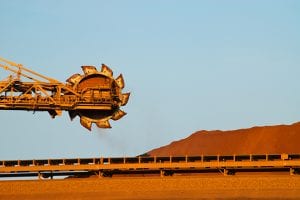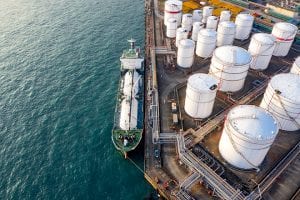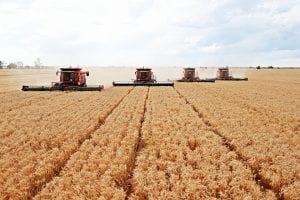2020 hammered home the futility of making annual predictions, but that doesn’t stop us from thinking ahead. As we peer into the future, notwithstanding the surprising extent of second wave lockdowns, 2021 promises to be a year of recovery from the COVID-19 collapse of 2020.
As global natural resources equity investors, we invest across the three subsectors of Mining, Energy and Agriculture. While the global economic backdrop and COVID-19 recovery is driving the demand for resources as a whole, I have separated the outlooks for each subsector so that I can provide a deeper understanding of the main drivers and outlook ahead.
Mining
 The Mining sector looks cheap, with an average free cash flow yield of 11% and average forward EV/EBITDA multiple of under 5. Balance sheets are strong, with limited uses of cash beyond returns to shareholders, underpinning dividend yields that are attractive, particularly in a zero-rate environment.
The Mining sector looks cheap, with an average free cash flow yield of 11% and average forward EV/EBITDA multiple of under 5. Balance sheets are strong, with limited uses of cash beyond returns to shareholders, underpinning dividend yields that are attractive, particularly in a zero-rate environment.
Ongoing iron ore demand
The sector also offers an inflation hedge, which could be attractive as the cycle matures amidst the $12 trillion stimulus-driven recovery. The ongoing commodity rally now implies average mark-to-market earnings upgrades of 20-30% for base metals companies and 50-80% for diversified miners exposed to rampant iron ore prices. The outlook for steel and iron ore is favourable for early 2021 and we have reduced underweights by adding to Fortescue, BHP and Champion Iron. With Vale ratchetting down expectations, we believe there will not be enough low-cost supply growth to meet incremental demand, so prices need to remain above long-term averages to ensure supply remains in the market. We expect a tight iron ore market in early 2021, a copper deficit from Q2, a tightly balanced aluminium market in China and similarly tight palladium and coking coal markets.
A risk factor we are closely watching are Chinese policies towards steel, raw materials, and renewable energy. In an attempt to counter the strength in iron ore prices, amidst a burgeoning trade dispute with Australia, Beijing’s newly released blueprint for its steel industry over the next five years includes cutting its reliance on the supply of raw materials it does not control.
Clean energy metals
As natural resources equity investors, we believe the clean energy transition and its impact on materials demand should not be overlooked and we are still exposed to energy transition metals such as copper, nickel and lithium. This is a global, multi-year trend, driven by the growing adoption of electric vehicles (EVs) and continued investment in renewable energy generation.
With many countries and corporations committing to net zero carbon emission targets by 2050, a massive transformation will be required to attain them. Commitment to these targets will result in strong demand for copper, nickel, aluminium, cobalt, lithium, graphite and various rare earths as they are key components in EVs and renewable energy generation infrastructure. Investment in new production capacity will be required to meet the predicted demand.
The path ahead for the yellow metal
No resources outlook can be complete without mentioning gold, which is recovering from a healthy correction within a longer term upcycle. The Democrats taking majority control of the US Senate provides an additional support to long term gold prices as President Biden will be more able to pass additional stimulus. Higher corporate taxes, tighter regulations, increased legal oversight of tech companies and infrastructure spending will require increased borrowing, making them dollar negative policies that Biden will look to push.
Alongside monetary debasement, gold bugs may well enjoy another year in the sun. We increased our gold exposure during the gold equity correction and we continue to favour large liquid seniors, alongside growthy midcaps where cashflow is inflecting upwards.
Energy
 Moving to the Energy sector, we continue to favour renewable energy exposure over fossil fuels, although we have decreased the exposure to renewables somewhat by pulling back on companies such as Vestas or Neste and switching into renewable developers like Algonquin, Nextera, Enel and Iberdrola, where we see better risk reward.
Moving to the Energy sector, we continue to favour renewable energy exposure over fossil fuels, although we have decreased the exposure to renewables somewhat by pulling back on companies such as Vestas or Neste and switching into renewable developers like Algonquin, Nextera, Enel and Iberdrola, where we see better risk reward.
In the oil sector, improving fundamentals, the return of inflation and prospects for further dollar weakness offer a path to higher oil prices. Currently the oil market is well balanced, as demonstrated by the backwardation of crude oil prices. Demand is down significantly year-on-year, vehicle miles travelled are running almost 20% below pre-COVID-19 levels and global aviation is down more than 40% year-on-year. This situation could reverse quickly as vaccines are rolled out globally.
With demand set to recover over the course of 2021, OPEC is the key variable in the market. OPEC can raise supply by several million barrels a day and maintain market balance as demand recovers. So far, they are showing decent cohesion, although cracks could easily appear in the OPEC edifice. The wildcard is Iran, where exports remain close to zero and there is some probability that these barrels return to the market in 2021 with a Biden-led rapprochement.
Despite improving oil market fundamentals, we are mindful of integrated oil. The sector is pricing in $50-$60 per barrel, meaning that it doesn’t look particularly attractive in our eyes unless the long end of the oil price curve improves. Given the multi-decade move away from fossil fuels, it’s hard to see that happening. Currently the 2030 oil future is priced at around $46 per barrel and remains steadfast despite the increase in current oil prices. In the last year, the industry has started the reset to lower oil prices with impairments, capex cuts and dividend cuts, but still arguably needs to do more. 2020 warning bells from the acceleration of renewables investment and potential cracks in OPEC+ suggest a need to be prepared for lower, rather than higher oil prices in the medium-term.
Elsewhere in Energy, we are paying close attention to gas prices, both domestic gas prices in the US and Europe, as well as international Liquified Natural Gas (LNG) markets. LNG in particular has rallied to record highs after global supply disruptions and high shipping rates conspired with recent winter weather conditions to accelerate market rebalancing. These conditions are favourable for several of our holdings, including North American gas producers Cabot, Seven Generations and Tourmaline, as well as Equinor in Europe.
Agriculture
 In the Agribusiness sector, the dominant themes are improving soft commodity prices, which bode well for farmer economics and by implication for crop inputs such as fertiliser, seeds, pest control and agricultural equipment.
In the Agribusiness sector, the dominant themes are improving soft commodity prices, which bode well for farmer economics and by implication for crop inputs such as fertiliser, seeds, pest control and agricultural equipment.
After a half-decade of largely weaker prices, bumper harvests, a devastating US-China trade policy rift, and most recently the coronavirus pandemic shock, staple cereals have finally broken out into what should be a sustained bull cycle. We enter 2021 with plenty of crop production concerns, including dryness damaging South American corn and soybean crops, as well winter wheat in Russia and the US. Brazil is suffering a rain shortfall which is hitting hopes for the country’s 2021 output of soybeans, coffee, cotton and sugar too.
Similarly, the pulp and paper cycle seems to have troughed, with a recovery in both pulp and containerboard prices underway. The bio-economy is growing and meets the mandates of green capitalism, searching for sustainable sources of plastic, packaging and construction materials. E-commerce penetration is positive for box demand as is a recovery in industrial activity. With their feet firmly in European green taxonomy, Smurfit Kappa, Stora Enso and UPM are at the forefront of some of these trends.
Diversified exposure to a diverse sector
Our strategies remain well-diversified to capture value across the range of opportunities in metals (copper, nickel, iron ore), gold, oil and gas production and technical services, renewable energy (especially in wind and offshore services and developers), agricultural products and high-quality food.
The principle driver of stock selection remains bottom-up driven and whatever the resource, we continue to invest in companies with world class assets, low costs, growth, strong balance sheets, good or improving environmental, social and governance profiles and strong management teams.
We hope and expect that 2021 brings some return to normality. As the world bounces back, we look forward to leveraging our resources expertise to generate returns for investors in 2021 and beyond.
Dollar figures are in US dollars (USD) unless otherwise specified.







